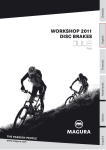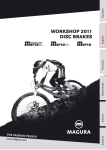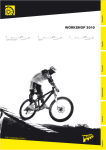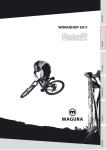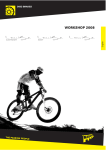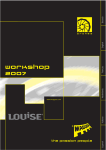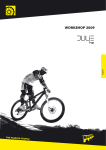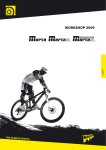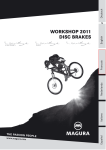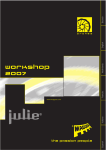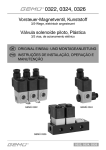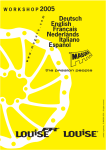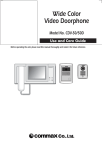Download WS LOUISE 2011 D.indd
Transcript
THE PASSION P www.magura.co m E O PL E Español Italiano Español ItalianoNederlands Nederlands Francais Français English English WORKSHOP 2011 DISC BRAKES Deutsch Deutsch Our disc brake range | recommended use Ground contact isn’t that important to you. There is (almost), no terrain where a Freerider won’t go. Tough and stable components are amust have. Here they are. FREERIDE Gustav M Gustav M Marta FR 203/203 Marta FR 203/203 There are bikers out therefor whom uphill is just a means to an end. The downhill fun is having absolute priority for them. With lots of travel and robust components the Enduros must cope with technically hairy downhills and bikepark weekends.. ENDURO Marta SL Magnesium 203/203 You’re an all-rounder. You love long and sweeping trails, up as well as down. The optimummix of light weight and stability is the hall mark of your AllMountain components meant for abroad spectrum of use. ALL MOUNTAIN Mile after mile over the dusty trails as well ashard fast tarmac. On every ride your bike shouldbe the epitome of uncomplicated – and naturally the parts for your X-country adventures shouldn’t cost the earth. X-COUNTRY XC RACE Marta SL Magnesium 203/203 Marta SL Magnesium 180/180 Marta SL Magnesium 180/180 Marta SL Magnesium 160/160 Marta SL Magnesium 160/160 Marta SL 203/203 Marta SL 203/203 Marta SL 180/180 Marta SL 180/180 Marta SL 160/160 Marta SL 160/160 Marta 203/203 Marta 203/203 Marta 180/180 Marta 180/180 Marta 160/160 Louise 203/203 Race-orientated means for us the minimum weight that is technically possible. Every gram extra weight can be the decisive factor between winning or losing for you, the racer maniac. Marta 160/160 Louise 203/203 Louise 180/180 Louise 180/180 Louise 160/160 Julie HP 203/203 Julie HP 180/180 Julie HP 160/160 Louise 160/160 Julie HP 203/203 Julie HP 180/180 Julie HP 160/160 Specifications subject to change without prior notice www.magura.com 2 4 2. Safety instructions before the first ride 5 3. Safety instructions before every ride 5-6 4. Transport of the bicycle 6 5. Brake installation 7-10 6. Shorten the hose 11-12 7. Maintenance/Brake pad change 13-14 8. Repairs 11. Accessories 18 12. Trouble Shooting 19 13. Warranty 19 14. Spare parts exploded view/Tuning adaptors 20-21 WARNING: This symbol means possible danger for your health and even life if you do not follow the instructions given resp. if the necessary safety measures are not followed. ATTENTION: This symbol warns you of inappropriate handling that might cause heavy damage to the material and/ or the environment. NOTE: This symbol is giving you additional information about the general handling of the product or gives hints to paragraphs of this manual which have to be read carefully. 3 Nederlands 18 Italiano 10. The disc brake wheel Français 16-17 Español 9. Bleeding and Filling 15 English 1. Introduction Deutsch Table of contents 1. Welcome to the Passion People! Brake lever (master cylinder) MAGURA Louise® Congratulations! You have purchased a fully hydraulic MAGURA disc brake proudly „Made in Germany“. You will be enthusiastic about the awesome braking power and the very little maintenance that is necessary on our stoppers. Good to know that you are not alone, millions of users worldwide rely on them and every day we’re becoming more!! Brake caliper and rotor MAGURA Louise® On the fully hydraulic MAGURA disc brake system MAGURA Louise the braking force is transmitted to the braking surface by a mineral oil column. The movement of the lever blade moves a piston, which is integrated in the brake lever (master cylinder). The piston pushes the mineral oil column through the brake hose in the direction of the brake caliper, where two pistons, on which the brake pads are fixed, are pushed out. The friction between the brake pads and the rotor is slowing down the bicycle and causes a heating of both the rotor and the brake caliper. Never touch either the rotor or the brake caliper after long braking as this may cause serious burns. You will be pleased to find out that the MAGURA Louise disc brakes offer a superior braking power even with little hand force applied, no matter what the weather conditions should be. Particularly in wet weather conditions disc brakes are much more responsive than rim brakes and transmit their enormous power shortly after activating the brake lever. Disc brakes do not cause a wear of your rims. In case of insufficient mounting conditions they might however cause a squealing noise during braking, mainly in wet weather conditions. This manual contains important information about the safe installation, operation and maintenance of your MAGURA disc brake. We urge you to read it carefully, become familiar with its contents and follow our recommendations to help make your new braking experience enjoyable and trouble free. Please note that the Louise brake is delivered in different versions with different rotor diameters and for different fitting alternatives for which we offer a variety of adaptors. The basic installations steps remain however always the same. Although the Louise disc brake system is relatively simple you should not overestimate your technical skills! We therefore advise you to leave the following works to a trained technician of a professional bike shop. This workshop manual is part of the product that must not be sold without it. In case of any further questions or problems we warmly recommend to visit our website www.magura.com where you will always find the newest and hottest tips about all our products and free online help around the clock in our forum. You can also download on magura.com this manual in a convenient A4 format. Stay tuned with the Passion People! Thank you for your confidence in our products, enjoy your ride and your new MAGURA disc stoppers! Happy trails! 4 5. Use the brakes according to the user chart on page 2 of this manual. Any misuse might cause heavy accidents with fatal injuries for you and others! 6. Are you familiar with the other components on your bike such as shifting, clipless pedals and suspension units? Always train the perfect handling of your bike in a safe area before using it in the public traffic. Consult the user’s manual of your bike to learn more about this. 7. For your own safety always wear a helmet when you ride a bicycle. Make sure as well that your clothing and footwear are suitable. 3. Before every ride or after a crash always check carefully the following points: 1. Always make sure that the quick release skewers of your wheels and seat post are correctly mounted and closed. Incorrectly installed quick release skewers might cause the fixed items to get loose. Serious falls with heavy bodily injury might be the result!! 2. Always make sure that the brake lever pressure is o.k. by pulling the lever blade and ensuring that full braking performance is achieved before the lever blade touches the handlebars. If this is not the case, pull the lever blade several times (pump) until the brake pads touch the rotor. In case, of changing pressure points during a ride you might have air in the brake system. See hints about filling and bleeding from on pages 16/17. 5 English Français 4. In case of extreme riding conditions (total weight of bike plus rider over 100 kg/220 lbs. and/or a gradient of more than 15 %) always use both brakes simultaneously to brake your bike down. Avoid constant braking on long descents as this might cause overheating and total failure of the system. Nederlands 3. New brakes and new rotors or brake pads must always be run in by breaking at least 30 times from a speed of 30 km/h to achieve the maximum brake power. Take your bike to a safe place to run in the brake. Italiano 2. Check whether you activate the front brake with the brake lever, which you are used to braking on the front. If ever this is not the case you will have to train your new setup because any unintended braking might cause an accident with possible serious injury! Make change the hose connection by a trained technician in case of any doubts. Further hints concerning the swapping of the brake hose see page 11 onwards. Español 1. Are you already familiar with hydraulic disc brakes? Our brakes might be much more powerful than the stoppers on which you relied so far. Take your bicycle to a safe area to learn the proper braking technique and operation of your new brakes and your bike. Deutsch 2. Before the first ride 3. Always make sure that the brake system does not have any leaks by activating the lever blade, holding it and checking the hose connections and reservoir cover for eventual leaks. (Also see page 12) 4. Always protect your rotors and brake pads from oil and lubricants (e.g. by lubricating your chain). Avoid detergents and soap on the brake pads. Contaminating the pads with oil and lubricants will cause a permanent loss of braking power. Those pads are definitely killed and cannot be saved. They have to be replaced! Clean a contaminated rotor with MAGURA brake cleaner, warm dishwater or alcohol. See further hints about the brake pad change on pages 13/14. 5. Release your brake lever and check whether your wheel moves freely and without drag. Check eventually whether the wheels are correctly mounted and if the quick release skewers are sufficiently tightened. (Also see pages 8-10) 6. Are your tires in a good condition, and are they sufficiently pressurized? Test this with your fingers. Lift up your bike and turn the wheels of your bike. An insufficient rotation might be due to damaged tires, broken axles and/or broken spokes. 7. Pick up your bike and let it drop from a moderate height. Be careful in case of any rattling noise. Check the bearings and all screwed connections. 8. Always follow the instructions given in the owner’s manual of your bicycle. Never use your bicycle if ever a proper function of the points mentioned above is not guaranteed. Consult a professional bike mechanic if you feel unsure. A faulty bicycle might cause serious accidents with possible serious injuries for the rider! 4. Transport of the bicycle In case of a disc brake equipped bicycle you should always keep in mind the following points: Never activate the lever blade without the brake pads in place and the wheels mounted. In case this should have happened see page 11 of this manual. Never throw away the transport device, which has been delivered with the brake. Always clip it between the brake pads whenever the wheel is removed (e.g. transport of the bike). Always carefully removed wheels. Make sure that the rotors are not damaged, deformed or contaminated with lubricants. If the bike is transported upside-down squeeze before the lever blade, hold pressure and fix the lever blade in this position with a rubber band or a cable tie as shown on the right photo. For a transport in an aircraft you can leave your brake as it is, e.g. you do not have to empty it. THE PASSION PEOPLE 6 5. Brake installation Allen key 2*, (2,5, 3) and 5 transport/mounting device* sharp knife 8 mm open end wrench flat blade screw driver Torx T25 key* (Torx T7 key) (*delivered with the brake) Always insert the allen and torx keys completely to avoid damaging the bolt heads! English Deutsch 1. Tools for installation (+maintenance) 10 2 9 12 Français 1 6 7 3 11 5 Nederlands 8 1. 2. 3. 4. 5. 6. 7. 8. 9. 10. 11. 12. brake lever (master cylinder) connected through the brake hose with the brake caliper with transport device; ATTENTION: remove the transport device only shortly before installation of the wheel! rotor fitting bolts for rotor Torx T25 (6 pieces) fitting bolts for caliper Allen key 5 (2 pieces) adaptor with fitting bolts (depending on model) hose inserts (2 pieces) olives (2 pieces) Torx T25 key 2mm Allen key Specifications modifying and improving this product are subject to change without prior notice. Specs may vary depending on model version! 7 Español Unpack your Louise disc brake: Italiano 4 The brake levers, calipers and hoses of the different MAGURA disc brake models are completely different and not compatible! Never mix and match parts from the different models! Any misuse might cause serious accidents! MAGURA manufacturers these braking systems according to the valid standards and based on profound product tests. Because of the large variety of forks and frames available on the market it is impossible for MAGURA to test all possible combinations. If you mount any of our brake systems always make sure that the brakes are in conformity with the bicycle. Disc brake calipers can generate a lot of heat during extreme riding conditions. The resulting heat transfer from the caliper to the fork and/or frame can have a negative influence on the mechanical characteristics of both the fork and/or the frame. Insufficient heat transfer from the brake caliper to the frame and the fork, caused by fork and or frame components having low heat transfer characteristics (e.g. carbon rear triangles) can cause the brake to overheat, with the possibility of a total failure of the brake system. This can cause serious personal injury to yourself and/or others. With respect to product liability we remind all our users that any manufacturer (also: bike mechanic or end consumer!) is responsible for the correct function of the complete bicycle in this context. Improper combinations and insufficient installation might cause damage and serious accidents! 2. Mount the brake lever to the handlebar with a 5 mm allen key. Tightening torque 4 Nm/ 34 in.lbs Hint: Tighten the brake lever so that it can still rotate around the handlebar in case of a crash. This old motocross trick will reduce considerably the risk of a damaged brake lever and the costly consequences. The MAGURA disc brake Louise is compatible with frames and forks which meet the International Standard (IS) and for Postmount (PM) mounts. Depending on the mounting standard and/or rotor size adaptors are used for a proper installation (cf. table on page 21). Never mount the brakes with adapters or brackets from other manufacturers! All warranty will be void in case of any misuse! Use only direct mounting parts from MAGURA or the frame or fork’s manufacturer! Make sure that the caliper fitting eyelets on your frame or fork are free of any paint, powder coating or burrs. (arrows). If this is not the case you should contact your dealer who is able to care for the absolutely necessary even surface with the help of the MAGURA Gnann-o-mat disc optimizer tool (also see page 10). ATTENTION: The facing of suspension fork lower legs made of magnesium might be dangerous because of corrosion! Always follow the safety instructions given by the respective manufacturer! Always make sure after having treated the disc brake mounts that these are protected against corrosion by using an appropriate protective paint. 8 7. Squeeze the lever blade several times (pump) to push the pads to their proper position until the lever feel becomes very firm. Tighten now the caliper fitting bolts. Tightening torque: 6 Nm/ 51 in.lbs. 8. For Postmount 6” installation in combination with a 160mm rotor, Postmount 7” with 180mm rotor or Postmount 8” with a 203mm rotor on the front you do not need an adaptor. Mount the caliper DIRECTLY onto the fork with MOUNTED wheel and rotor. For a better understanding the mounted wheel is not shown on this picture. Do not tighten the caliper bolts yet! Squeeze the lever blade and keep the pressure. Tighten now the bolts. Tightening torque: 6 Nm/ 51 in.lbs. Further mounting alternatives cf. page 21 of this manual. 9 Deutsch English Français 6. The transport device prevents the brake pads from being pushed out too far by unintended lever squeeze when the wheel is removed. It is impossible then to install the wheel with the rotor. So never throw away the transport device but keep it and always clip it between the brake pads as shown when the wheel is removed. Install the wheel by positioning the rotor between the brake pads and fixing the wheel in the dropouts. Close the quick release of your wheel which you should mount on the opposite side of the brake caliper and tighten it sufficiently. Nederlands 5. Mount the rotor with the 6 Torx T25 bolts onto the hub. Use only new original bolts or thread lock if you use the old ones again. Tighten the bolts in a cross pattern. Tightening torque: 4 Nm/ 34 in.lbs. Install a MAGURA rotor in Centerlock version according to the tech sheet that comes with the rotor. Italiano 4. Caliper installation: Mount the caliper with MOUNTED wheel and rotor onto the adaptor. For a better understanding the mounted wheel is not shown on this picture. Do not tighten the caliper bolts yet! Squeeze the lever blade and keep the pressure. Tighten now the bolts. Tightening torque: 6 Nm/ 51 in.lbs. Español 3. Mount the adaptor onto the fork or the frame. Use a 5 mm allen key. Please follow carefully the mounting instructions that come with the respective adaptor! If you use a thru-axle hub on the front you might have to use thicker 3 mm spacers (depending on fork model). These are available separately (code: 0720 829). Tightening torque: 6 Nm/ 51 in.lbs. 9. Hose routing with the Heat Eater fitting. The Heat Eater fitting of the Louise caliper allows a 45° rotation for the optimum hose routing without using tools. Fix the hose on the fork and/or frame after you have found the ideal position, the Heat Eater must NOT move during compression of the fork and/or frame! Do not worry when you hear friction between rotor and pads. A slight drag is normal on disc brakes with automatic pad wear adjustment during the break-in period. This drag will disappear after a while. The reason for this is that the brake pads find their optimum working position towards the rotor, only after a slight wear during the break-in period. Slight drag might also happen after a brake pad change or in case of an incorrectly installed wheel. In case of a constantly dragging disc brake causing noise your frame is badly aligned. In such a case you should contact your dealer who can care with the MAGURA Gnann-o-mat disc optimizer for a totally even surface of the disc brake mounts. These are absolutely necessary for a drag free function of your brake. New brakes and/or new rotors or brake pads must always be run in by breaking at least 30 times from a speed of 30 km/h to achieve the maximum brake power. Take your bike to a safe place to run in the brake. 10. Reach adjust is done with a 2,5 mm Allen key. Turning key clockwise: lever blade moves away from the handlebar, turning counterclockwise: blade moves to the handlebar. On Louise models without BAT feature you find the reach adjust screw under the black dust cover of the lever blade. WARNING: The reach adjust screw becomes very firm when you risk to overtighten it. Do not continue to screw it in/ out in such a case. Misuse can lead to brake failure! The adjust screw must not be flush wih the drill in the lever blade. Re-install the dust cover once you have adjusted the reach adjust properly. 11. Bite Adjust Technology (BAT): Turning clockwise: Turning counterclockwise: Bite point becomes firmer Bite point becomes softer. WARNING: Do not adjust the reach adjust in the closest position to the handlebar in combination with a BAT adjuster that is screwed in to the maximum as well. This could result in an unsufficient lever movement and brake power. Check out after every change of the BAT and/or reach adjust the function of the brake to get used to the changed handling of the brake. 10 Never push back the pistons without the brake pads mounted! Open the brake system only after having pushed back fully the brake pads. 2. Loosen the brake lever clamping screw with a 5 mm allen key. Turn the brake lever and ensure that the reservoir points approx. 15° upwards from the horizontal position. 3. Slide the hose protection. Unscrew the sleeve nut on the brake lever with an 8mm open-end wrench and pull the hose out carefully. Hold the hose carefully to avoid any loss of oil! Do not squeeze the lever blade with the system open! English Español 4. Put the hose on a workbench and shorten it with a sharp knife. The best tool is the MAGURA hose cutter. Do not use saws or pliers! Français 1. Remove the wheel so that you have free access to the brake caliper. Push both pistons with brake pads mounted back by putting the transport device or a flat blade screwdriver into the gap. Move the screwdriver slowly back and forth until both caliper pistons are fully retracted and flush with caliper body. Nederlands Never touch either the rotor or the brake caliper after long braking as this may cause serious burns. Italiano Louise is a high-pressure system and comes with a reinforced hose, the „MAGURA Disc Tube“ wearing also this imprint. The Disc Tube needs an additional insert for a proper fitting. Never mix and match the parts from the MAGURA Louise with the ones of our rim brakes or other manufacturers’ brakes! Any misuse might cause serious accidents! Deutsch 6. Shorten the hose 11 Hint: Hold the hose carefully so that it cannot snap away! Cut the hose squarely! The sleeve nut can be re-used. The olive and the insert cannot be reused and must be replaced! 5. Press by hand a new insert into the hose until it is fully seated. Clamp the hose into the groove of the mounting device as shown... 6. ...or clamp the mounting device as shown into a vice and hammer the insert carefully into the hose. 7. Slide on the sleeve nut and a new olive onto the hose. Push the hose with the sleeve nut and the new olive fully into the brake lever and tighten the sleeve nut with an 8 mm open-end wrench. Tightening torque: 4 Nm/34 in.lbs. 8. Always check for correct installation by pulling on the hose. Make sure that the system has no leaks. Squeeze the lever blade, hold pressure and check hose connections and the reservoir cover for eventual leaks. Squeeze the lever blade several times (pump) to push the pads to their proper position until the lever feel becomes very firm. If you cannot realize this, bleed the brake (see page 16 onwards). THE PASSION PEOPLE 12 Control of the brake pad wear Never touch either the rotor or the brake caliper after long braking as this may cause serious burns. Squeeze the lever blade with the wheel mounted an hold the pressure. Check out whether the “finger” of the transport device fits in-between the “ears” of the brake pads. On the picture on the left this is NOT the case, the pads must be changed! Here the “finger” of the transport device fits between the “ears” of the brake pads. The pads are still o.k. Remember: The lever has to be pulled during this procedure. Use for this a rubber band or a cable tie. Replacement of the brake pads 1. Remove the wheel so that you have free access to the brake caliper. Push both brake pads fully back by putting the transport device or a flat blade screwdriver into the gap. Move the screwdriver slowly back and forth until both caliper pistons are fully retracted and flush with the caliper body. Never push back the pistons without the brake pads mounted, the pistons could be damaged otherwise. 13 English Français Brake pads: wear, control and replacement Brake pad wear: The brake pads are subject to wear due to friction between rotor and pads. All Louise disc brakes feature a fully automatic pad wear adjustment. Regularly check the thickness of your brake pads and replace them, if necessary! CHANGE AL WAYS BOTH PADS SIMULTANEOUSLY! Nederlands As to hints about repairs of the hose see page 15 onwards. Italiano Always make sure that the brake system does not have any leaks by activating the lever blade, holding it and checking the hose connections and reservoir cover for eventual leaks. Consult a trained technician in case of leaks that cause poor braking performance with possible serious accidents! Español Brake Oil: MAGURA disc brakes use a transmission medium low viscosity mineral oil, the MAGURA ROYAL BLOOD. Contrary to DOT brake fluid the MAGURA ROYAL BLOOD does not irritate human skin or strip the paint of your frame. Moreover it does not absorb water like DOT and does not have to be changed regularly. What sounds unbelievable is a fact: you can use your brakes over years without having to touch them (except brake pad check and change!) Use exclusively MAGURA ROYAL BLOOD, any other oil will damage the seals of your brake what will result in total failure of the brake! Deutsch 7. Maintenance 2. Remove the brake pad fitting screw with a 2mm allen key. 3. Pull out the brake pads. Their „ears“ make this very easy. Minimum thickness of a brake pad plus holder is 2,5 mm. Never squeeze the lever blade without the brake pads in place and the wheel mounted! If this happened by accident push back the pistons by using the transport device or a flat blade screwdriver. Use only genuine MAGURA brake pads! MAGURA cannot guarantee a correct function of the brake if you use brake pads from other manufacturers, which were not tested! Using other pads (e.g. sinterized ones!) might cause poor braking, overheating of the system and resulting total brake failure causing serious accidents! All warranty claims will be void in case of misuse! 4. Clean on the occasion of the brake pad change, the brake body with a clean rag. Make sure that the friction side of the new brake pads points towards the rotor. 5. Secure the new pads with the fitting screw, a new one is delivered with the new pads. Tightening torque: 1 Nm/ 9 in.lbs. Check the correct fitting of the pads by pulling them. The fitting bolt of the pads has to be correctly installed e.g. it has to go through the drills of the pad holders and then correctly screwed into the caliper. 6. Re-install the wheel and check for a correctly tightened quick release skewer of the wheel which should be mounted on the opposite side of the caliper. 7. Squeeze the lever blade several times (pump) to push the pads to their proper position until the lever feel becomes very firm. New brakes and/or new rotors or brake pads must always be run in by braking at least 30 times from a speed of 30 km/h to achieve the maximum brake power. Take your bike to a safe place to run in the brake. Never contaminate brake pads with oil or grease this causing permanent loss of brake power! Contaminated pads are definitely killed and must be replaced! 14 2. Prepare a new hose: Use only the reinforced MAGURA Disc Tube (wearing also this imprint). One end of this hose comes with a pressed fitting with blue loctite threadlock, which has to be screwed into the Heat Eater as described above. The hose is available with 0° and 90° fittings (c.f. page 20) Tightening torque: 6 Nm/ 51 in.lbs. Use with all Louise models with adjustable Heat Eater hose fitting only the hose that comes with the fitting with blue loctite threadlock (arrow!). NEVER shorten the MAGURA Disc Tube hose at the end with the pressed fitting! You could no longer use this hose then. 3. Tighten the prepared end of the new hose onto the Heat Eater. Tightening torque: 6 Nm/ 51 in.lbs. 4. Install the hose as described in chapter 6. English Español After the installation of a new hose you will always have to refill the brake. The following chapter 9 describes how the filling and bleeding has to be done. Français 1. Remove the damaged hose from both the brake lever and the caliper. Nederlands Louise is a high-pressure systems and comes with a reinforced hose, the „MAGURA Disc Tube“ wearing also this imprint. The Disc Tube needs an additional insert for a proper fitting. Never mix and match either the hoses or parts from other manufacturers. Any misuse might cause serious accidents! Italiano Disc brake service kit Don’t panic if the hose snaps! With the disc brake service kit and a separately available spare hose (see spare parts pages 20/21), this can be repaired easily. Deutsch 8. Repairs 15 9. Filling and bleeding a brake Brake Oil: MAGURA disc brakes use as transmission medium low viscosity mineral oil, the biodegradable MAGURA ROYAL BLOOD. Contrary to DOT brake fluid the MAGURA ROYAL BLOOD does not irritate human skin or strip the paint of your frame. Moreover it does not absorb water like DOT and does not have to be changed regularly. What sounds unbelievable is a fact: you can use your brakes over years without having to touch them (except brake pad check and change!) Use exclusively MAGURA ROYAL BLOOD, any other oil will damage the seals of your brake what will result in total failure of the brake! 1. Loosen slightly the clamping screw of the brake lever with a 5mm allen key and ensure that the reservoir points upwards approx. 15° from the horizontal position. Slightly tighten the clamp screw in that position. 2. For filling and bleeding a MAGURA disc brake you will need the disc brake service kit including all necessary tools. 3. Prepare the transparent filler tube by pushing in by hand the M6 barbed fitting. Put the other end of the filler tube on the syringe and fill the syringe completely with MAGURA ROYAL BLOOD mineral oil. Fill the syringe completely and make sure that there are no air bubbles inside. Turn the syringe eventually to push out air bubbles. 4. Remove the brake pads as described on page 14 and slide the transport device as shown with its THICK END between the caliper pistons. Squeeze slightly the lever blade (pump) to tighten the transport device. It is advisable to fix the device with a rubber band on the caliper. 5. Fix the Heat Eater fitting of the caliper so that it points UPWARDS!. IUnscrew now the bleed screw with a 5 mm allen key. Screw in the prepared syringe and tighten it with a 8 mm open end spanner. Place now a rag, which has to be free of oil or lubricants around the reservoir and, more important, around the brake caliper. Care for a clean working environment! No dirt or particles may come into the brake system! 16 10. Before you remove the syringe on the reservoir make sure that there is only a small quantity of oil inside. Place a rag around the brake lever and the caliper thus preventing overflowing oil from dropping down and contaminating and killing the brake pads. Remove the syringe and close the end that was inserted into the reservoir quickly with your finger. Empty the remaining content of the syringe into an container. 11. Close the plug on the reservoir cover as shown by pressing it by hand into the drill. That’s it! 12. Remove the filling syringe and screw in the 5mm allen bleed screw. Tightening torque: 2,5 Nm/ 22 in.lbs. Re-install the brake pads and the wheel. Always pull the lever blade several times (pump) until the brake pads touch the rotor. Always check for correct installation by activating the lever blade and checking for eventual leaks. Never contaminate brake pads with oil or grease this causing permanent loss of brake power! Contaminated pads are definitely killed and MUST be replaced! A contaminated rotor can be cleaned with MAGURA brake cleaner, warm dishwater or alcohol. 17 Deutsch English Français 9. Actuate in addition CAREFULLY the lever blade to chase tiny air bubbles that might hide within the system. The job is done when no air bubbles can be seen after having followed the steps above several times. Nederlands 8. Now suck the oil carefully back with the filling syringe on the brake caliper. Make sure that there is always enough oil in the reservoir syringe when you suck back the oil with the filling syringe! You will see air bubbles again. Italiano 7. Put the second syringe of the service kit WITHOUT PLUNGER into the opened drill of the reservoir cover. Push oil from the brake caliper upwards until the oil column arrives in the syring on the reservoir. You will see air bubbles now. Español 6. Remove ONLY the bleed plug of the reservoir with a 2,5mm Allen key that you insert into the plug before turning it slightly. The reservoir cover and the membrane underneath remain on the brake lever! 10. The disc brake wheel The XC disc brake wheel There already exists enough literature concerning wheels, so just a few tips how a well-built X-country disc brake wheel has to be. Use spokes with a diameter of 2 mm (arc)/ 1,8 mm which you cross three times. No radial lacing with disc brake wheels! Head-inside-spokes (=arc-outside-spokes have to be pulled, i.e. these spokes point forward on the front wheel; on the back wheel these spokes point forward on the rotor side and backwards on the drive side. All spokes have to be stressed equally and high. Mount the q/r skewer of the wheel on the opposite side of the caliper! Never use ultra lightweight quick releases with titanium or aluminum axles for your wheel sets in combination with a disc brake. You will not be in a position to realize the necessary tightening torque! 11. Accessories MAGURA disc brake service kit contains everything that you need for bleeding and repairing a brake. ATTENTION: the kit does NOT include a spare hose! MAGURA braided hose for all MAGURA disc brakes easily shortened with a cable cutter Order codes see on page 20. Watch out for the genuine hose with yellow MAGURA marker!! Use only genuine MAGURA brake pads! brake pads Performance Type 6.1 code 0722 418 series pad for maximum brake power. brake pads Endurance Type 6.2 code 0722 419 with optimized longevity. Use only genuine MAGURA accessories! Any parts manufactured by other manufacturers like lever blades, hoses or brake pads have not been tested and approved by MAGURA and consequently nothing can be said about their short and long-term function. Never use those parts! All warranty and product liability claims will be void in case of misuse! Never change the paint, the finish or the consistence of your brake. This might cause total failure of the whole system with possible serious consequences! 18 break in brake (page 5) oil/lubricants on rotor and/ or pads clean rotor with MAGURA brake cleaner, warm dish water or alcool. Replace contaminated pads! air in the system Bleed brake (page 16) Correct transport (page 6) Check hose connections and hose for leaks. Replace hose if necessary (page 16) leaking system Squealing brake badly aligned frame align brake caliper correctly (page 9) paint/powder coating on disc remove any paint or powder mounts coating and care for an even contact surface without burrs (page 8/9) wheel q/r skewer insuffiincrease tightening; mount ciently tightened q/r skewer on opposite side Insufficiently tightened wheel of caliper; care for evenly spokes spoked wheel Contaminated brake pads carelessness change brake pads Contaminated rotor carelessness clean rotor with MAGURA brake cleaner, warm dish water or alcohol Wheel cannot be mounted Lever blade was pulled with removed wheel push back the brake pads with transport device or a flat screwdriver (page 11) Rattling noise and rough deceleration brake pads worn, holder of pads is wearing and damaging the rotor brake pad change (page 13) Leaking hose or brake accident, incorrect installation change hose or defective brake lever/caliper (page 15) 13. Warranty MAGURA is giving a 5-year leak proof warranty on brake levers (master cylinder) and brake calipers. Watch out for the red info sheet in the middle of this manual! 19 English brake not run in Français not enough brake power no pressure point Nederlands solution Italiano reason Español problem Deutsch 12. Trouble shooting 14. Spare parts 2011/max. tightening torques 0722 533 lever blade repair kit (1x) 0722 525 BAT Carbon (1x) 0722 526 BAT Alu (1x) 0720 847 Torx T7 key (10x) 0721 000 0,6 Nm (10x) 0724 044 0722 531 0722 527 (1x) Storm SL Rotor 6 holes (IS) 203 mm 0724 404 180 mm 0724 403 160 mm 0724 402 140 mm 0724 401 0724 134 weiss 0722 535 silver 0722 536 black incl. bolt 0721 778 (10x) 0720 825 (10x) 0720 916 (20x) 0721 057 (6x) 4 Nm Louise Carbon/white left 0724 133 right 0724 132 Louise BAT/black left 0724 331 right 0724 330 Louise/black left 0722 524 right 0722 523 0720 446 (10x) 4Nm 0721 204 Torx T25 key 0720 405 (10x) 0721 057 (6x) 4 Nm 0722 636 hose 250 cm 6 Nm 0721 386 braided hose 250 cm 6 Nm Storm Rotor 6 holes (IS) 203 mm 0724 400 180 mm 0724 399 160 mm 0724 398 0722 421 (10x) 6 Nm 10 x 0720 848 2,5 Nm 0721 418 Type 6.1 Performance 0721 419 Type 6.2 Endurance Titanium bolt kit 0722 562 1x M5x18 6x M5x10 2x M6x18 0720 828 (10x) 1 Nm 0721 314 white silver black 0722 528 0722 529 0722 530 Specifications are subject to change without prior notice! 20 Scheibendurchmesser mm/Anbau/Bremse Bestellnummer Adaptor Rotor diameter mm/installation/brake order code Adaptateur Diamètre disque mm/montage/frein référence N°. 5 203/Int. Standard 6“ VR/Front/AV 0722 321 N°. 6 180/Postmount 6“ VR/Front/AV 0722 322 N°. 7 203/Postmount 6“ VR/Front/AV 0722 323 N°. 8 203/Rockshox Boxxer ➞ 2009 0722 324 N°. 9 203/Int. Standard HR/Rear/ARR 0722 325 N°. 10 180/Int. Standard HR/Rear/ARR 0722 424 N°. 11 160/Int. Standard 6“ VR/Front/AV 0722 425 203/Int. Standard 8“ Fox 40 Français Adapter Nr. English Deutsch 15. Adaptors/mounting alternatives for Louise 2009 180/Int. Standard 6“ VR/Front/AV 180/Int. Standard HR/Rear/ARR 0722 426 (Julie 2005-2008) 160/Int. Standard 6 HR/Rear/ARR N°. 14J 210/Int. Standard 6” VR/Front/AV (Julie 2005-2008) 0722 453 190/Int. Standard HR/Rear/ARR (Julie 2005-2008) N°. 15J 210/Postmount 6” (Julie 2005-2008) N°. 26 203/Postmount 7” MAGURA Thor 0724 131 N°. 27 160/Postmount 5“ 0724 495 N°. 28 180/Postmount 5“ 0724 496 Direktanbau Direct mount Montage direct 203/Postmount 8” VR/Front/AV 180/Postmount 7” VR/Front/AV (MAGURA Thor) 140/Postmount 5“ HR/Rear/ARR 160/Postmount 6” VR/Front/AV 180/Postmount 6” VR/Front/AV (Julie 2005-2008) 0722 454 WARNING! Always make sure, that the fixing bolts are screwed in to a depth of at least 8 mm. This corresponds to around 8 full turns! Should this not be the case, longer bolts, with a minimum hardness of 8.8 should be used and secured using blue Loctite. Specifications are subejct to change without prior notice ! Visit our website magura.com for further information, tech tips and free online help!! 21 Italiano N°. 12 (Julie 2005-2008) Español 160/Int. Standard HR/Rear/ARR Nederlands 180/Int. Standard 6“ VR/Front/AV (Julie 2005-2008) > CHECK OUT OUR WORLDWIDE PARTNERS AND SERVICE CENTERS ON MAGURA.COM! Deutschland MAGURA Bike Parts GmbH + Co. KG Heinrich-Kahn-Strasse 24 89150 Laichingen phone +49 (0)7333 9626-0 fax + 49 (0)7333 9626-17 [email protected] USA MAGURA USA 724 West Clem 62450 Olney, Illinois phone 6183952200 fax 6183954711 magura@ magurausa.com © MAGURA 2010 All rights reserved Printed in Germany 0689 724, 07.2010 S ION P THE PAS gura.c www.ma om E O PL E Asia MAGURA Asia Limited Co. No. 160, Sec. 1, Chang-an Road Shi-Tun District 40743 Taichung City, Taiwan phone +886 4 2316 3388 fax +886 (04) 2315 4030 [email protected] Apollo 11 | Germany > SIE FINDEN UNSERE WELTWEITEN HANDELSPARTNER UND SERVICE CENTER AUF MAGURA.COM!






















